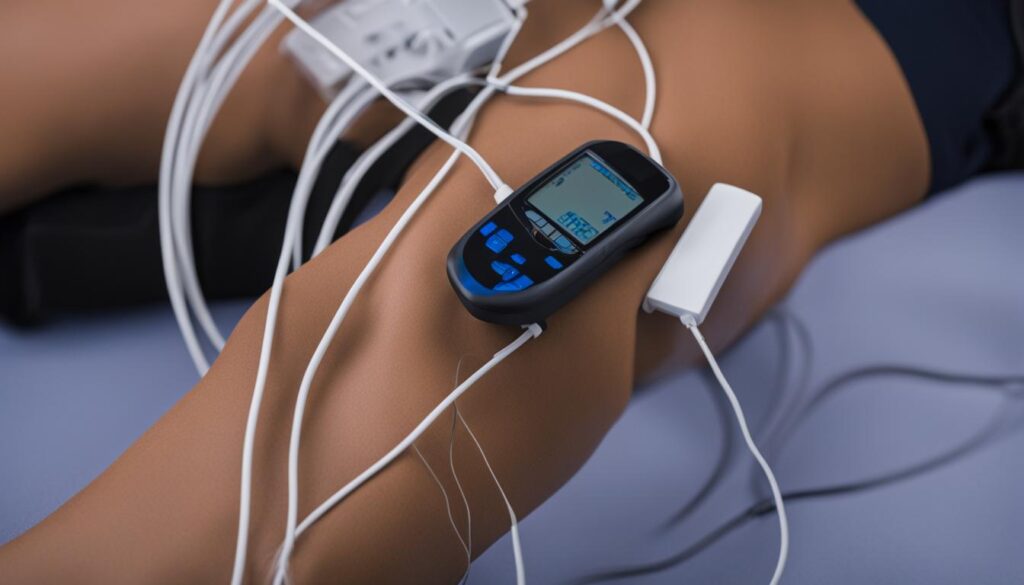Unlock Your Best Run: Essential Tips for Post-Run Recovery
After an intense running effort, it's important to give your body the recovery time it needs to bounce back and repair muscle. Soreness after a hard long run or intense training session is common and can be reduced with proper recovery techniques. From pre-run warm-up to post-run nutrition, there are several essential tips you should incorporate into your routine to maximize your recovery and optimize your overall running performance.
Key Takeaways:
- Pre-run warm-up is crucial for reducing muscle soreness and preventing injuries.
- Stretching after a run helps maintain flexibility and range of motion.
- Taking a warm shower promotes blood flow and aids in muscle recovery.
- Foam rolling can help break down muscle fibers and promote blood flow for faster recovery.
- Hydration, nutrition, rest days, and sufficient sleep are all crucial for optimal recovery and performance.
The Importance of Pre-Run Warm-Up for Recovery
Before setting off on your run, it's crucial to give your body the proper warm-up it needs to reduce muscle soreness and prevent injuries. A pre-run warm-up routine prepares your muscles and tissues for the demands of running, improving overall performance and aiding in recovery.
Start by incorporating light jogging into your warm-up routine. This helps increase blood circulation and warms up your muscles and tissues. Gradually increase your pace to simulate the intensity of your upcoming run.
Dynamic stretching is another essential component of a pre-run warm-up. Focus on exercises that target the muscles you'll be using during your run, such as your calves, quads, and hamstrings. Dynamic stretches involve controlled movements that stimulate blood flow and improve flexibility. Examples include leg swings, walking lunges, and high knees.
By incorporating a pre-run warm-up into your routine, you'll not only reduce the risk of muscle soreness and injuries, but you'll also optimize your body's ability to recover post-run.
Benefits of Pre-Run Warm-Up:
- Reduces muscle soreness
- Prevents injuries
- Improves overall performance
- Increases blood circulation
- Enhances flexibility
The Power of Stretching for Post-Run Recovery
After completing a run, engaging in post-run stretching is a vital aspect of recovery. Not only does it help reduce muscle soreness, but it also plays a key role in improving flexibility and overall athletic performance. By incorporating post-run stretching into your routine, you can ensure that your muscles stay healthy and resilient, allowing you to consistently perform at your best.
Reduce Muscle Soreness
One of the primary benefits of post-run stretching is its ability to reduce muscle soreness. When you run, your muscles contract and tighten, which can lead to discomfort and stiffness. Stretching after your run helps alleviate this soreness by lengthening and relaxing the muscles. By targeting key areas such as the calves, quads, and other leg muscles, you can effectively minimize post-run muscle soreness.
Improve Flexibility
Regular stretching after your run also helps improve flexibility and range of motion. This is important for runners, as increased flexibility can lead to better running form and reduced risk of injuries. Through consistent stretching, you can enhance the elasticity of your muscles and joints, allowing for a greater range of motion. This increased flexibility not only improves your running efficiency but also helps prevent the development of tight or imbalanced muscles.
Effective Stretching Techniques
To make the most of your post-run stretching routine, it's essential to utilize effective stretching techniques. One commonly recommended approach is performing static stretches, holding each stretch for 15-30 seconds. This length of time allows the muscles to fully relax and elongate. Additionally, focusing on deep breathing during your stretches can enhance the relaxation response in your body, promoting further muscle recovery.
| Tip | Description |
|---|---|
| Target key areas | Focus on stretching the calves, quads, and other leg muscles |
| Perform static stretches | Hold each stretch for 15-30 seconds for optimal muscle relaxation |
| Breathe deeply | Incorporate deep breathing to enhance relaxation and promote muscle recovery |
By following these stretching tips and incorporating post-run stretching into your routine, you can experience reduced muscle soreness, improved flexibility, and enhanced overall recovery. Remember to listen to your body and adjust your stretching routine as needed. With consistent practice, you'll be on your way to unlocking your best run and achieving your running goals.
The Benefits of a Warm Shower for Muscle Recovery
After a challenging run, giving your body the proper recovery time is essential to support muscle repair and reduce soreness. One effective method that promotes muscle recovery is taking a warm shower. Not only does a warm shower feel comforting after a long run, but it also has numerous benefits for your muscles.
Taking a warm shower after a run helps promote blood flow, which is crucial for muscle recovery. The warmth of the water dilates blood vessels, allowing more oxygen-rich blood to reach the muscles. This increased blood flow aids in removing waste products and toxins that may have accumulated during the run, speeding up the recovery process.
In addition to promoting blood flow, a warm shower can also provide an opportunity to massage your legs and feet. Gently massaging your muscles can further aid in recovery by reducing muscle tension and promoting relaxation. This can help alleviate any lingering soreness or tightness after your run.
“A warm shower after a run promotes blood flow and aids in muscle recovery.”
Incorporating a warm shower into your post-run routine can have significant benefits for your body. Not only does it help with muscle recovery, but it also provides a moment of relaxation and self-care, allowing you to unwind after a challenging run. So, the next time you finish a run, treat yourself to a warm shower and let its healing properties support your body's recovery process.

The Power of Foam Rolling for Post-Run Recovery
Foam rolling is a highly effective technique that can aid in post-run recovery by targeting muscle soreness and promoting blood flow. This self-myofascial release technique involves using a foam roller to apply pressure to different areas of the body, helping to break down muscle fibers and release tension. By incorporating foam rolling into your recovery routine, you can experience faster recovery, reduced muscle soreness, and improved overall performance.
One of the key benefits of foam rolling is its ability to break down muscle fibers. After a run, your muscles may become tight and knotted due to the repetitive stress they undergo. Foam rolling helps to release these knots, allowing for better blood circulation and nutrient delivery to the muscles. This can lead to faster recovery and reduced muscle soreness.
“Foam rolling can be a game-changer for runners. It helps to improve flexibility, reduce muscle adhesions, and promote blood flow, all of which are crucial for optimal recovery.”
In addition to breaking down muscle fibers, foam rolling also promotes blood flow to the muscles. By applying pressure to different areas of the body, you stimulate the circulatory system, increasing blood flow and flushing out toxins. This can help reduce inflammation and promote faster muscle recovery.
When incorporating foam rolling into your post-run recovery routine, it's important to focus on the areas that need the most attention. This may include the quads, hamstrings, calves, and glutes. Spend a few minutes on each muscle group, applying gentle pressure and slowly rolling back and forth. Remember to breathe deeply and relax your muscles as you foam roll.
| Benefits of Foam Rolling for Post-Run Recovery |
|---|
| Breaks down muscle fibers |
| Promotes blood flow |
| Reduces muscle soreness |
| Improves flexibility |
| Helps release muscle tension |
In conclusion, foam rolling is a powerful tool for post-run recovery. By incorporating this technique into your routine, you can experience faster recovery, reduced muscle soreness, improved flexibility, and overall enhanced performance. Remember to listen to your body and adjust the pressure and intensity of the foam rolling based on your individual needs. Happy rolling!
The Benefits of Using CBD-Based Recovery Products
When it comes to post-run recovery, finding effective ways to alleviate muscle soreness and pain is essential. One option that has gained popularity among runners is the use of CBD-based recovery products. CBD, or cannabidiol, is a natural compound derived from the hemp plant that has been found to have anti-inflammatory properties.
Using CBD-based recovery balms or lotions can help reduce muscle soreness and alleviate pain. The anti-inflammatory properties of CBD can help reduce inflammation in the muscles, allowing for faster recovery. By incorporating CBD-based recovery products into your post-run routine, you can enhance muscle recovery and promote overall well-being.
Using CBD-based recovery products can provide short-term relief from muscle soreness after a run or intense training session.
One of the benefits of CBD-based recovery products is their ability to provide targeted relief. Applying a CBD balm or lotion directly to the sore muscles allows the CBD to penetrate deep into the tissue, providing localized relief. This targeted therapy can help soothe specific areas of muscle soreness and discomfort.
| Benefits of CBD-Based Recovery Products |
|---|
| Alleviates muscle soreness |
| Reduces inflammation |
| Provides targeted relief |
It's important to note that CBD-based recovery products do not contain THC, the psychoactive compound found in marijuana. This means that using CBD-based products will not cause a “high” or any psychoactive effects. CBD is non-intoxicating and can be safely incorporated into your post-run recovery routine.
With their ability to alleviate muscle soreness, reduce inflammation, and provide targeted relief, CBD-based recovery products can be a valuable addition to your post-run recovery routine. By incorporating these products into your routine, you can optimize your recovery, enhance your muscle repair, and get back on the road feeling rejuvenated and ready for your next run.
The Role of TENS Machine in Muscle Recovery
When it comes to post-run recovery, finding effective methods to relieve muscle soreness is key. One such method gaining popularity among runners is the use of a TENS (Transcutaneous Electrical Nerve Stimulation) machine.
A TENS machine is a device that provides targeted therapy for muscle soreness relief. By sending electrical impulses to the muscles, it stimulates nerve endings and reduces pain. This targeted approach can be particularly beneficial for runners who experience soreness in specific areas or have localized injuries.
Using a TENS machine as part of your post-run recovery routine can help alleviate muscle soreness and promote faster recovery. By providing targeted relief, it allows you to focus on specific areas that need attention, offering a more personalized recovery experience.
With its ability to provide targeted therapy, a TENS machine is a valuable tool in the runner's recovery arsenal. Incorporating this method into your routine can help you recover faster, reduce muscle soreness, and get back to running at your best.

The Benefits of Using a TENS Machine
Using a TENS machine for muscle recovery offers several benefits:
- Targeted Relief: The electrical impulses delivered by the TENS machine provide targeted therapy, focusing on specific areas that need attention.
- Pain Reduction: The stimulation of nerve endings helps reduce pain and discomfort associated with muscle soreness.
- Improved Recovery: By alleviating muscle soreness, a TENS machine promotes faster recovery, allowing you to get back to your regular running routine more quickly.
- Personalized Experience: With adjustable settings, you can customize the intensity and frequency of the electrical impulses to suit your comfort level and specific recovery needs.
With its ability to provide targeted therapy and reduce muscle soreness, a TENS machine is an effective tool for runners looking to enhance their post-run recovery. Consider incorporating this method into your routine to experience the benefits firsthand.
The Importance of Hydration and Nutrition for Recovery
Proper hydration and nutrition play a vital role in post-run recovery. When we run, we sweat, losing both water and electrolytes. It's crucial to replenish these fluids to ensure our bodies function optimally. Without proper hydration, we risk muscle cramps, fatigue, and decreased performance. To maintain hydration levels, we recommend drinking water before, during, and after your run.
In addition to fluid intake, nutrition is essential for muscle repair and recovery. Consuming a protein shake within an hour after your run helps repair and rebuild muscles. Protein provides the building blocks necessary for muscle growth and repair. Combining carbohydrates with protein helps replenish glycogen stores, providing energy for future runs.
The Role of Electrolytes
Electrolytes are minerals that help maintain fluid balance, muscle function, and nerve signaling. Sodium, potassium, magnesium, and calcium are important electrolytes for runners. Including foods rich in these electrolytes, such as bananas, leafy greens, and yogurt, can support muscle recovery and prevent dehydration.
“Proper hydration and nutrition play a vital role in post-run recovery.”
While it's important to focus on hydration and nutrition immediately after your run, it's also crucial to maintain a well-balanced diet overall. Eating nutrient-dense whole foods, such as fruits, vegetables, lean proteins, and whole grains, provides essential vitamins and minerals for overall health and recovery.
| Hydration Tips | Nutrition Tips |
|---|---|
|
|
Remember, proper hydration and nutrition are not only important for recovery but also for overall health and performance. By fueling our bodies with the right nutrients and staying hydrated, we can unlock our best runs and achieve our running goals.
The Benefits of Rest Days for Runners
Rest days are a crucial aspect of any training regimen, and their importance cannot be overstated. Taking regular rest days is essential for preventing injuries and optimizing performance. During rest days, our bodies have the opportunity to recover and repair the muscles that are strained during intense runs. This recovery period is vital for avoiding overuse injuries and ensuring that we can continue training effectively in the long run.
Rest days also play a significant role in preventing the negative effects of overtraining. When we push ourselves too hard without allowing sufficient rest, our stress hormone levels can increase, impeding tissue repair and prolonging muscle soreness. By incorporating rest days into our training schedule, we give our bodies time to recover and reset, improving overall performance and reducing the risk of burnout.
Moreover, rest days contribute to our mental well-being and motivation. They provide a necessary break from the physical demands of running, allowing us to recharge and stay mentally refreshed. This mental rejuvenation is crucial for maintaining a positive mindset, preventing workout monotony, and staying motivated to achieve our running goals.
| Key Benefits of Rest Days for Runners | How Rest Days Can Help |
|---|---|
| Prevent Injuries | Rest days give our muscles and connective tissues time to repair and rebuild, reducing the risk of overuse injuries. |
| Optimize Performance | By allowing our bodies to rest and recover, we optimize our performance potential and ensure that we are performing at our best during workouts. |
| Prevent Overtraining | Rest days help regulate stress hormone levels, preventing the negative effects of overtraining, such as decreased immune function and decreased performance. |
| Mental Well-being | Rest days provide a break from the physical demands of running, allowing us to recharge mentally and stay motivated. |
“Rest when you're weary. Refresh and renew yourself, your body, your mind, your spirit. Then get back to work.” – Ralph Marston
The Role of Sleep in Recovery and Performance
Sleep plays a crucial role in the process of muscle repair and growth. When we sleep, our body enters a state of rest and restoration, allowing for the release of important hormones that aid in tissue repair and stimulate muscle growth. Hormones like testosterone and insulin-like growth factor are released during deep sleep, promoting muscle repair and recovery.
A lack of sufficient sleep can have a negative impact on our body's ability to recover. It can impede tissue repair, increase stress hormone levels, and affect mood and motivation. When we don't get enough sleep, our body struggles to repair the micro-tears in our muscles caused by intense physical activity, leading to prolonged muscle soreness and decreased performance.
To support optimal recovery and performance, it is recommended to aim for 7 to 9 hours of sleep per night. Establishing a consistent bedtime routine can help signal to our bodies that it's time to wind down and prepare for rest. Creating a sleep-friendly environment with a cool room temperature, comfortable bedding, and minimizing noise and distractions can also contribute to quality sleep. Prioritizing sleep as part of our recovery routine is essential for maximizing the benefits of our training efforts.
“Sufficient sleep is not just a luxury; it is a necessity for our body's recovery and overall well-being. It allows our muscles to repair, our hormones to regulate, and our mind to recharge. Make sleep a priority in your post-run routine, and watch how it enhances your performance.”
The Power of Sleep in Hormone Regulation
Quality sleep also plays a significant role in hormone regulation. It helps maintain the balance of hormones responsible for managing appetite, metabolism, and energy levels. When we are sleep-deprived, the hormones that control hunger and fullness become imbalanced, leading to increased cravings and a higher likelihood of making poor food choices. This can hinder muscle repair and impede post-run recovery.
| Hormone | Role | Impact of Sleep Deprivation |
|---|---|---|
| Leptin | Suppresses appetite | Decreased levels, leading to increased hunger |
| Ghrelin | Stimulates appetite | Increased levels, leading to increased hunger |
| Cortisol | Stress hormone | Elevated levels, leading to muscle breakdown and impaired recovery |
By prioritizing sleep and ensuring an adequate amount of rest, we can regulate these hormones and support our body's post-run recovery process. Getting enough quality sleep is just as important as the training itself when it comes to achieving our running goals.
Remember, sleep is not an optional extra, but a fundamental aspect of recovery and performance optimization. Incorporate a proper sleep routine into your post-run recovery plan to unlock your body's true potential and achieve your running goals.
Conclusion
Proper post-run recovery is crucial for our muscle repair, preventing injuries, and optimizing performance. By following these essential tips for post-run recovery, we can ensure that our bodies bounce back quickly and efficiently.
We begin by prioritizing pre-run warm-up, which not only reduces muscle soreness but also helps prevent injuries. Gradually slowing down and doing easy running or walking after our runs aids in recovery by bringing down our heart rate and allowing our bodies to cool down naturally.
Stretching after a run is another vital step. By focusing on our calves, quads, and other leg muscles, we can reduce post-run muscle soreness and maintain or improve our flexibility and range of motion.
Incorporating additional recovery techniques can also greatly benefit us. Taking a warm shower promotes blood flow and aids in muscle recovery. Foam rolling breaks down muscle fibers and promotes blood flow for faster recovery. Using CBD-based recovery products and TENS machines can alleviate muscle soreness and provide targeted relief.
Hydrating properly, consuming a balanced diet, and prioritizing rest days are also essential for our overall recovery and well-being. And let's not forget the importance of sufficient sleep, which plays a significant role in muscle repair and growth.
By incorporating these essential tips into our post-run routine, we can unlock our best run and enhance our running journey. So let's prioritize recovery and take our running to the next level!
FAQ
What are some essential tips for post-run recovery?
After an intense running effort, it's important to give your body the recovery time it needs to bounce back and repair muscle. Soreness after a hard long run or intense training session is common and can be reduced with proper recovery techniques.
Why is pre-run warm-up essential for recovery?
Pre-run warm-up is essential to reduce muscle soreness and the risk of injuries. Light jogging and dynamic stretching before a run warm up muscles and tissues, increase blood circulation, and improve flexibility. A good warm-up can also help prevent common running injuries.
How does stretching aid in post-run recovery?
Stretching your calves, quads, and other leg muscles after a run helps maintain flexibility and range of motion. Regular stretching helps maintain or improve flexibility and range of motion. Stretching after a run aids in reducing muscle soreness and preventing injuries.
What are the benefits of a warm shower for muscle recovery?
Taking a warm shower after a run promotes blood flow and aids in muscle recovery. The warmth of the water helps increase blood circulation, leading to faster recovery. The shower also provides an opportunity to massage your legs and feet, further aiding in recovery.
How does foam rolling help with post-run recovery?
Foam rolling is a popular method for aiding post-run recovery. It helps break down muscle fibers, improve blood flow, and speed up recovery. Foam rolling can reduce muscle soreness and prevent the formation of adhesions in the muscles. It is particularly effective for larger muscles like quads and glutes.
What are the benefits of using CBD-based recovery products?
Using CBD-based recovery balms or lotions can help alleviate muscle soreness and pain. CBD has anti-inflammatory properties, which can aid in reducing inflammation in the muscles. CBD-based products can provide short-term relief from muscle soreness after a run or intense training session.
What is the role of a TENS machine in muscle recovery?
TENS (Transcutaneous Electrical Nerve Stimulation) machines provide targeted relief from muscle soreness and certain running injuries. TENS machines can be used to prepare muscles between workouts and aid in recovery. They work by sending electrical impulses to the muscles, stimulating nerve endings, and reducing pain.
How important is hydration and nutrition for recovery?
Hydration is essential for recovery, with water and electrolytes replenishment being important. Consuming a well-balanced diet with nutrient-dense whole foods aids in post-run recovery and overall running performance. Drinking a protein shake within an hour after your run helps repair and rebuild muscles. Post-run meals should include a balance of protein and carbohydrates to support muscle repair and replenish glycogen stores.
What are the benefits of rest days for runners?
Rest days are essential for preventing injuries and optimizing performance. Rest allows the body to recover and repair muscles strained during runs. Lack of rest can lead to increased stress hormone levels, hinder tissue repair, and prolong muscle soreness. Rest days also contribute to mental well-being and motivation.
What role does sleep play in recovery and performance?
Sufficient sleep is crucial for muscle repair and growth. Hormones like testosterone and insulin-like growth factor are released during deep sleep, aiding in tissue repair and stimulating muscle growth. Lack of sleep can impede tissue repair, increase stress hormone levels, and affect mood and motivation. Aim for 7 to 9 hours of sleep per night, and establish a consistent bedtime routine to support optimal recovery and performance.
What are some concluding notes on post-run recovery?
Proper post-run recovery is crucial for muscle repair, preventing injuries, and optimizing performance. Incorporating essential tips such as pre-run warm-up, stretching, warm showers, foam rolling, CBD-based recovery products, TENS machine therapy, hydration, nutrition, rest days, and sufficient sleep into your routine can enhance muscle recovery and improve your overall running journey.
Source Links
- https://www.locklaces.com/blogs/resources/recovery-tips-after-running
- https://www.trailandkale.com/tips/running-recovery-tips-to-recover-quicker/
- https://www.brooksrunning.com/en_no/blog/advice-tips/recovery-and-rest-tips.html











Leave a Reply